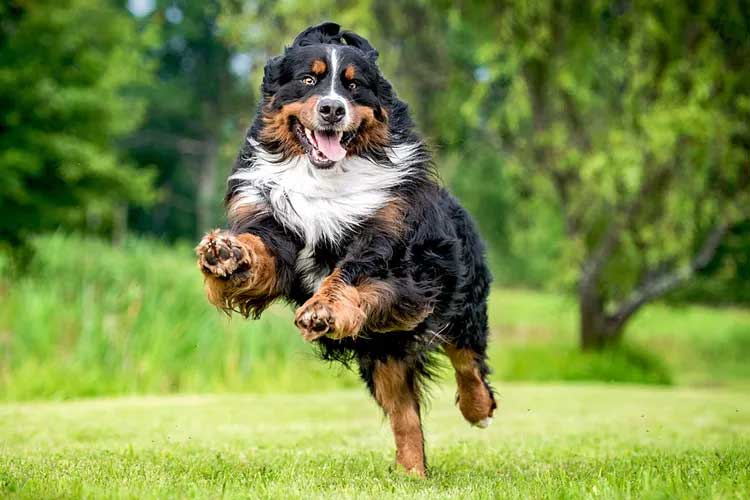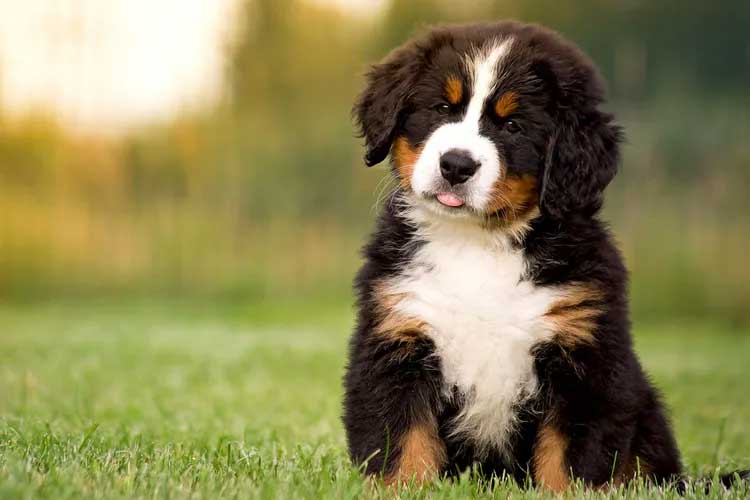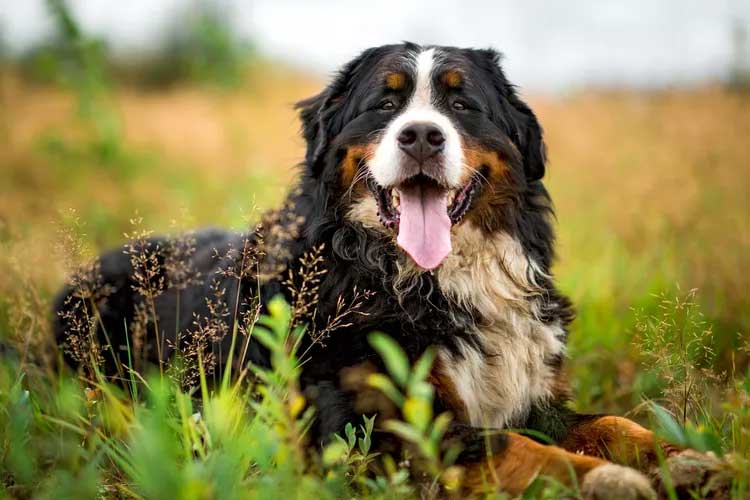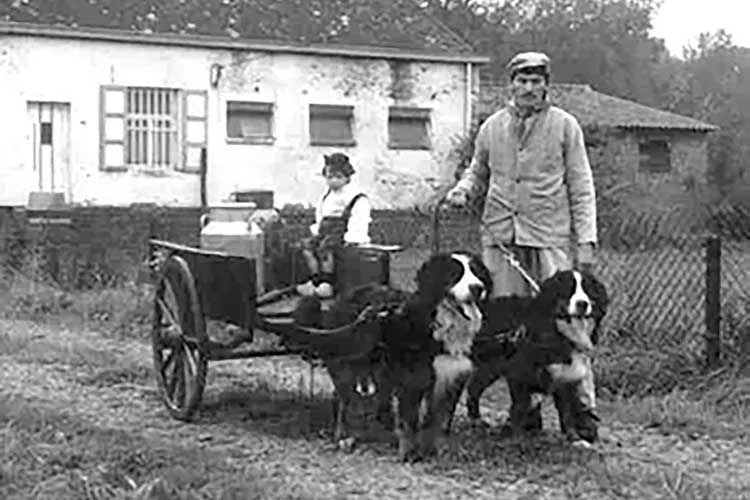Bernese mountain dogs are smart, hardworking, and loyal dogs who love to spend time with their human family. Learn more about living with Bernese mountain dogs.

Bernese Mountain Dog Overview
| OFFICIAL NAME | Bernese Mountain Dog |
| COMMON NAME | Bernese Mountain Dog |
| PET HEIGHT | 23 to 27 inches |
| PET WEIGHT | 70 to 115 pounds |
| LIFESPAN | 7 to 10 years |
| GOOD WITH | cats, children, dogs, families, seniors |
| TEMPERAMENT | aloof, friendly, gentle, playful |
| INTELLIGENCE | high |
| SHEDDING AMOUNT | frequent |
| EXERCISE NEEDS | medium |
| ENERGY LEVEL | calm |
| VOCAL LEVEL | when necessary |
| DROOL AMOUNT | medium |
| BREED GROUP | working |
| BREED SIZE | large (61-100 lbs.) |
| COAT LENGTH | long |
| COLORS | black, brown / chocolate / liver, white |
| PATTERNS | tricolor |
| OTHER TRAITS | cold weather tolerant, easy to train, good for first-time pet owners, good hiking companion, prone to health issues, requires lots of grooming, strong loyalty tendencies |
Bernese mountain dogs, known as "Berners" to their fans, are beloved for their sweet, calm, easygoing nature and their devotion to their families, including small children. Big and strong Berners, which historically helped with farming duties in Switzerland, are able to pull carts and act as guard dogs. When they're not working or playing, these smart, loyal dogs are happiest at their owner's side, wherever that may be.
Appearance
Bernese mountain dogs are large—they weigh between 70–115 pounds and can be 23–27.5 inches tall at the shoulder—and have a welcoming spirit and expressive dark brown eyes. Bernese mountain dog puppies even resemble plush dog toys. These sturdy dogs are tricolored, with a thick black coat and distinctive white and rust markings on the face. The moderately long and silky coat can be straight or slightly wavy.
"Bernese mountain dogs are so sweet looking," Jami-Lyn Derse, DVM, founder of Veterinary Housecall Care in Chicago, says. "To me, they always look like they're smiling. I think that's because of the mask they have on their faces."
Temperament
The Bernese mountain dog's trainability and eagerness to please has charmed owners since the dog's earliest days on Swiss farms. "It's one of my all-time favorite breeds," Derse says. "They're smart, they're quick learners, and they're exceptionally faithful dogs."Derse, who says the Bernese mountain dog is growing more popular in the United States, describes them as "low-energy" and says that they enjoy plenty of downtime with their people, whether it's playing in the yard or lazing on the couch. They do not like to be alone. The Bernese mountain dog is patient, calm, affectionate, and a great pet for families, though they can be somewhat aloof with strangers. If properly socialized when young, Berners get along well with cats and other dogs.

Bernese mountain dogs have long acted as guardians for livestock and, considering their large size and intimidating bark, make good watch dogs. However, with their loving and gentle nature, owners shouldn’t expect much real threat behind the bark.
Living Needs
Because of their thick coats, Berners are best suited for colder climates. "They love the winter," Derse says. "I have gone to clients' houses in a blizzard and their Bernese mountain dogs will be laying in the snow, just as happy as can be. They do not want to go in the house."Bernese mountain dogs enjoy having space to explore, so a fenced-in yard is recommended, Derse says, and regular walks are important. The Bernese Mountain Dog Club of America recommends at least a half hour of brisk walking or running every day. This dog makes an excellent companion for outdoor activities, like hiking and camping, and can even pull kids around in carts. Bernese mountain dogs also do well in activities such as tracking, agility, and herding.
Care
"If you're going to get a Bernese mountain dog puppy, get a Roomba, too," Derse says. "Because they shed like crazy. Expect a lot of grooming. And a lot of vacuuming." A Berner's silky double-layer coat will need brushing every couple of days and full grooming every four to eight weeks.Training and socialization should start early and should emphasize positive behavior rather than harsh corrections. Berners are sensitive and like to make their owners happy, so they tend to respond well to positive reinforcement. Just don't leave a Berner alone for too long, or they may find trouble.

Your Bernese mountain dog should eat dog food made from high-quality ingredients. Monitoring food and exercise is an important part of care, as Berners can eat a lot. A visit to your vet can help you determine how much and how often to feed your dog.
Health
There are a number of conditions that could impact the health of a Bernese mountain dog, Derse says, including cancer. "They get a lot of types of cancers, in particular, and they don't have as long of a lifespan because of that," Derse says. The Bernese mountain dog lifespan is generally 7–10 years.
Bernese mountain dogs are also prone to a few conditions commonly associated with large dogs, such as elbow and hip dysplasia, blood disorders, and eye conditions. Owners also need to be wary of gastric dilatation-volvulus (GDV) complex, or bloat, which is a stomach condition that happens when air accumulates in the stomach, causing it to twist. Bloat can be life-threatening and requires emergency surgery. There are some steps owners can take that may diminish the risk of bloat, according to VCA Hospitals, such as feeding the dog smaller, more frequent meals during the day.
Owners should talk to their veterinarian about risks for these conditions and how they can reduce them.
History
The Bernese mountain dog originally came from Bern, Switzerland, where they worked on farms driving cattle, pulling carts, and guarding fields and farms on mountains and in valleys. The breed is one of four ancient Swiss breeds, known as Sennenhund breeds, and was brought there, it's believed, by the Romans. The Bernese mountain dog—then and now—has a reputation for strength, smarts, and companionship.As farming and ranching modernized, demand for this type of dog decreased and the population declined. But enthusiasts for the breed responded and led a concerted effort to bolster the breed's numbers. A respected European dog lover named Professor Albert Heim took notice of the Bernese mountain dog and formed a breeding club in 1907 to popularize the smart, gentle dog, and the pups returned to favor on farms as well as with families.
The dogs caught the attention of a Kansas farmer in 1926, who imported a duo to help around his property. Other farmers took note, and so did the American Kennel Club, which registered the breed in 1937.

Fun Facts
This breed is remarkably strong and can pull up to 10 times their own weight, or nearly 1,000 pounds!Thanks to their cart-pulling abilities, Bernese mountain dogs once served as delivery dogs, drawing carts filled with dairy products, bread, and other items from farm to farm. Today, they may be more likely to flex those skills for their owners, pulling children in carts for fun.
Of the four Sennenhund breeds, known collectively as Swiss mountain dogs or Swiss cattle dogs, only the Bernese mountain dog has long hair. The other not-quite-so-furry breeds in this group are the Greater Swiss mountain dog, the Appenzeller mountain dog, and the Entlebucher mountain dog.
Because of the small rust-color markings above Berners’ eyes, they are sometimes known as vieräugler (“four eyes”) dogs.
Luna the Berner is Insta-famous, with more than 100,000 fans who follow her adventures.